|
|
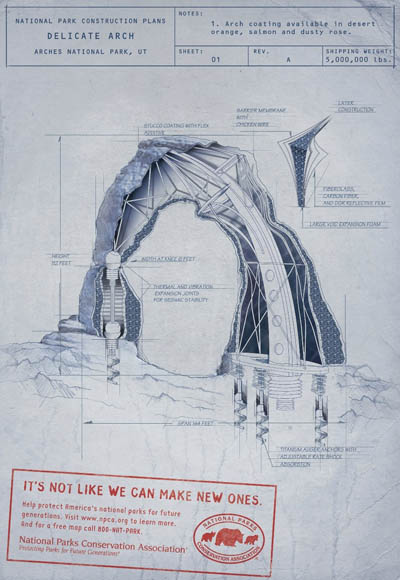 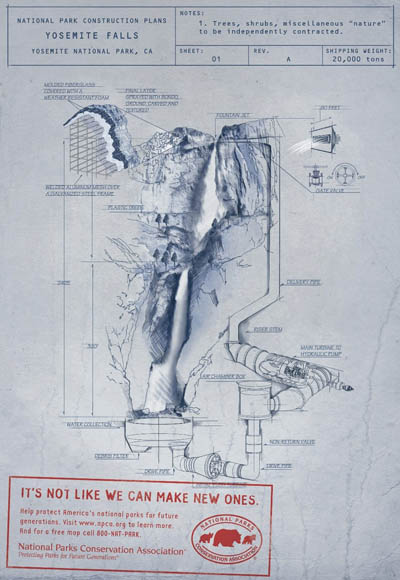 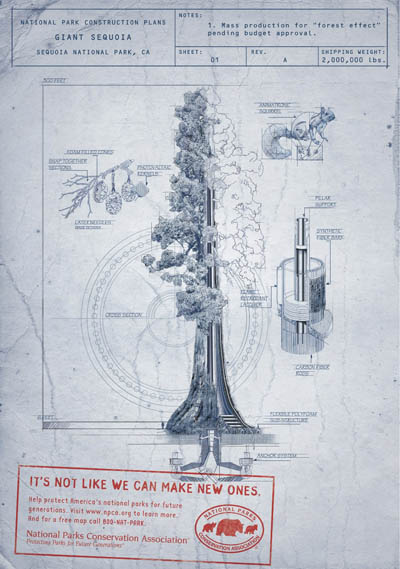 [Images: An ingenious ad campaign by Y&R for preserving America's National Parks: landscapes blueprinted, seeds diagrammed, arches shock-absorbed. Here are Delicate Arch ( PDF), Yosemite Falls ( PDF), and Giant Sequoia ( PDF)]. (Thanks to Eric Jamieson for the tip!)
There was a short article in the August 2004 issue of The Wire about sound artist Mark Bain. "Equipped with seismometers," The Wire writes, Bain "can turn architectural structures into giant musical instruments and demolish buildings with sound alone." His installations have included "sensing devices, oscillators and the occasional sculptural element" – such as the "six metre high inflatable speaker" featured below.  This is the Sonusphere, formerly installed in the Edith Russ Haus, Germany. The Sonusphere musicalizes the effects of plate tectonics: "Modified seismic sensors pick up the normally unheard movements of the earth and are channeled through the entire building until reaching a 'crescendo' in Bain's sonusphere. Unique in its purpose and design, the sonusphere is essentially a wired, inflatable ball that fills the entire upper floor and takes signals generated from an acoustic network running through the entire architecture. It acts as a low frequency, 360 degree, acoustic radiator translating the sound to its curved walls as physically pulsating sound pressure." Bain's work, The Wire explains, references "the ideas of maverick engineer Nikola Tesla." Tesla's prolific output and avant-garde electrical ideas inspired Bain to develop "a system for resonating buildings that allowed him to 'play' structures. 'The multi-resonator system I designed could drive waveforms into buildings,' Bain comments, 'like giant additive synthesis where you get different beatings of frequencies and shifted harmonics. I was basically designing systems that turned a structure into a musical instrument.'" Elsewhere, we're told, "the portable earthquake machines [that Bain] showed in Holland in 2001 produced severe tremors that spread through the surrounding area. Then there was Het Paard, a large music venue in The Hague slated for demolition. The oscillators he attached to the building activated the entire structure, inflicting severe damage on parts of the walls and ceilings." Of course, Bain has been on BLDGBLOG before, where we discuss a musical composition of his made entirely from seismic data recorded during the collapse of the World Trade Center on 9/11 – the trembling of Manhattan turned into a roar of sound. (Listen to an excerpt here). (Similar ideas are taken up in this post).
 [Image: The supercomputer pictured above is the MareNostrum, "meaning 'our sea,'" New Scientist writes; "it is housed in a 1920s chapel at the Technical University of Catalonia in Barcelona, Spain, and built from commercially available parts." Photo by Simon Norfolk]. [Image: The supercomputer pictured above is the MareNostrum, "meaning 'our sea,'" New Scientist writes; "it is housed in a 1920s chapel at the Technical University of Catalonia in Barcelona, Spain, and built from commercially available parts." Photo by Simon Norfolk]."The supercomputers I'm showing here are powerful almost beyond human understanding," photographer Simon Norfolk explains, describing his extraordinary new images of supercomputers and their architectural settings. "They can map every molecule of the billions on a human DNA string; scrutinise at the atomic level the collision between two pieces of plutonium in an exploding bomb; or sketch the gravitational pull of every star in the galaxy upon every other star in the galaxy. These are not questions that humans could grapple with given plenty of time, a notebook and a sharp pencil." Norfolk has also photographed computers used for "mapping and predicting global virus outbreaks" and for "simulating automotive crash tests."  [Image: "Modeling physics inside an exploding nuclear warhead." Simon Norfolk]. [Image: "Modeling physics inside an exploding nuclear warhead." Simon Norfolk].These computers, Norfolk continues, "are omniscient and omnipresent and these are not qualities in which we find a simulacrum of ourselves – these are qualities that describe the Divine. The problem is not that these computers might one day resemble humans; it is that they already resemble gods." 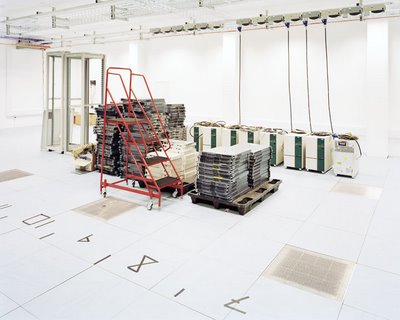   [Images: Simon Norfolk. The top image is titled "Mapping the human genome." The others are the TERA-1 and the TERA-10]. [Images: Simon Norfolk. The top image is titled "Mapping the human genome." The others are the TERA-1 and the TERA-10].In almost supernaturally sterile rooms, these angelic landscapes of silicon quietly hum their way through introspective worlds of calculation: derivatives, logorithms, advanced topologies. One could, in fact, imagine a whole new series of Duino Elegies, written by a posthumous Rainer Maria Rilke, in terrified praise of these cloistered machines – machines Rilke seems to describe preemptively in his "Seventh Elegy," where the "annihilator" meets the "Angel." Rilke writes that "the external shrinks into less and less": Where once an enduring house was,
now a cerebral structure crosses our path, completely
belonging to the realm of concepts, as though it still stood in the brain.
Our age has built itself vast reservoirs of power,
formless as the straining energy that it wrests from the earth.
Temples are no longer known. In this context, it seems almost like an act of religious sarcasm that the MareNostrum computer – pictured at the top of this post – has been housed in a chapel. (Of course, a consecrated supercomputer is certainly a stunning intellectual possibility – perhaps setting up the plot of Da Vinci Code 2, wherein future archaeologists discover that the Vatican is not a complex of buildings at all but a fully functioning Jesuit supercomputer). In any case, because all harddrives are actually geological objects – careful rearrangements of minerals under the influence of manmade magnetic fields – then these are mathematical terrains in the most exciting sense: the surface of the earth dreaming of spherical velocities inside otherwise undetectable stellar detonations.   [Images: Two close-ups of cerebral machines. Simon Norfolk]. [Images: Two close-ups of cerebral machines. Simon Norfolk]. Finally, Giordano Bruno, following Giulio Camillo, wrote extensively about the idea of a Memory Palace, or Memory Theater. As Victoria Nelson tells us, the basic idea was that an "esoterically trained memory was a godlike vessel for encapsulating the entire universe within a single human mind." This was part of what Nelson calls a Neoplatonic "quasi-religion" that "venerated memory as an organ possessing magical and world-ordering powers." Neoplatonists believed that "the whole cosmos could be 'memorized' in a much more overt imitatio dei and by this act magically incorporated into the human organism" – or, of course, into the air-cooled circuits of a supercomputer. So if I were forced to take issue with the existence of these machines, it would not be because of their use in modeling new nuclear warheads – as Norfolk makes clear they do – but in something far more secondary, even faintly absurd: what I'd call the lack of a supercomputer poetics, or a more imaginative role for these machines to play in our literary and even religious lives. Oracular, Delphic, radically non-secular: they are either all or none of the above. (With sincere thanks to Simon Norfolk, who supplied all the images that appear in this post. And don't miss BLDGBLOG's later interview with Simon Norfolk, in which he discusses his war photography in much greater detail).
 [Image: "Glowing, silvery blue clouds that have been spreading around the world and brightening mysteriously in recent years will soon be studied in unprecedented detail by a NASA spacecraft." New Scientist]. Some unrelated items of atmospheric news... First, the phenomenon of " noctilucent clouds" is under investigation. These are clouds "which glow at night, form in the upper atmosphere, at an altitude of about 80 kilometres, and their glow can be seen just after sunset or just before sunrise. 'Even though the Sun's gone down and you're in darkness, the clouds are so high up, the Sun is still illuminating them.'" However, could a city deliberately build upward curving traps of air, thermally concentrating moisture in huge, rising chimneys, giving its citizens a kind of Air TV – abstract films of silvery blue clouds coiling across the sky, mercurial and noctilucent? Gone would be Seasonal Affective Disorder; in its place you'd have this fairy tale gossamer light, glowing metallic on the edges of all things. Add to that the microscopic sounds of water crystallizing inside distant clouds – amplified throughout the canyons of the city – and you'd have a kind of climatopia. Meanwhile, "many of the skyscrapers in Shanghai could become quite dangerous" due to the high winds they're now producing. This effect is seemingly parodied in Mission Impossible III when Tom Cruise parachutes out of a Shanghai skyscraper – only to find that his chute fails to open due to the torque of neon whirlwinds lashing him about between corporate bank towers. (Yes, I've seen Mission Impossible III). In an inadvertant moment of architectural criticism, "the Shanghai municipal government identified skyscrapers as one of the biggest potential threats to the city." Ages ago, in a no doubt now embarrassing BLDGBLOG post, the idea of urban wind-guns was explored, wondering, simultaneously, what impact surburban tract housing might have on the storms that eventually blow through a city. Fences, back porches, forests cut down or left to grow: how do these affect the speed of regional wind systems?  [Image: By krisstr, from the Shanghai Flickr group]. Shanghai city authorities have more or less answered that question, suggesting that "more trees can be planted to block part of the winds," and that "the walls of the buildings should be fortified while notice signs are put up to signal potentially dangerous areas." Pockets of atmospheric turbulence within the city. (How do skyscrapers affect the flight-paths of airplanes?) Finally, air wells, tropospheric rivers, and electromagnetic weather control all meet in this surprisingly long but very interesting article. There, we discover that "huge filamentary structures" in the sky act as "preferable pathways of water vapor movement in the troposphere (the lower 10-20 km of the atmosphere) with flow rates of about 165 million kilograms of water per second. These 'atmospheric rivers' are bands from 200 to 480 miles wide and up to 4,800 miles long, between 1-2 kilometers above the earth. They transport about 70% of the fresh water from the equator to the midlatitudes, are of great importance in determining the location and amount of winter rainfall on coastlines."  [Image: The aforementioned tropospheric rivers, a kind of fluted cobwebbing of intercontinental air pressure]. The following devices – towers, air wells, etc. – were all designed to help tap into these rivers, turning the sky itself into an aquatic reservoir.   You basically build one of those things at a geo-atmospherically strategic location; you make youself a cup of tea; their height and geometry trigger downdrafts; then the internal chambers cause condensation of vapor from air. Thus, an air well. The end of drought through tropospheric riverways. Here's a diagram of one of the machines working:  The article, of course, also discusses electromagnetic weather control, such as the notorius HAARP Project, pictured here –  – but there's a (very little) bit more on that in an earlier post. (Thanks to Scott Webel for the air wells article; and to the incomparable things magazine for the link about Shanghai).
This is the final part of a two-part interview with Mike Davis, author, sociologist, and urban theorist, recorded upon the publication of his book, Planet of Slums. If you missed part one – or just plain miss it – here it is.  In this installment, Davis discusses the rise of Pentecostalism in global mega-slums; the threat of avian flu; the disease vectors of urban poverty; criminal and terrorist mini-states; the future of sovereignty; environmental footprints; William Gibson; the allure of Hollywood; and Viggo Mortensen's publishing imprint, Perceval Press. •BLDGBLOG: In an earlier, essay-length version of Planet of Slums, you write at some length about the rise of Pentecostalism as a social and organizational force in the slums – but that research is missing from the actual book, Planet of Slums. Are you distancing yourself from that research, or perhaps less interested now in its implications?Davis: Actually, several hundred pages on Pentecostalism are now being decanted in the second volume, written with Forrest Hylton, where they properly belong. But the historical significance of Pentecostalism – evangelical Christianity – is that it’s the first modern religious movement, I believe – or religious sect – which emerged out of the urban poor. Although there are many gentrified Pentecostal churches in the United States today, and even in places like Brazil, the real crucible of Pentecostalism – the spiritual experience which propels it – the whole logic of Pentecostalism – remains within the urban poor. Of course, Pentecostalism, in most places, is also, overwhelmingly, a religion of women – and in Latin America, at least, it has an actual material benefit. Women who join the church, and who can get their husbands to join with them, often see significant increases in their standard of living: the men are less likely to drink, or whore, or gamble all their money away. For someone like myself, writing from the left, it’s essential to come to grips with Pentecostalism. This is the largest self-organized movement of poor urban people in the world – at least among movements that emerged in the twentieth century. It has shown an ability to take root, dynamically, not only in Latin America but in southern and western Africa, and – to a much smaller extent – in east Asia. I think many people on the left have made the mistake of assuming that Pentecostalism is a reactionary force – and it’s not. It’s actually a hugely important phenomenon of the postmodern city, and of the culture of the urban poor in Latin American and Africa. BLDGBLOG: Outside of simply filling a void left behind by the retreat of the State, what's the actual appeal of Pentecostalism for this new generation of urban poor?Davis: Frankly, one of the great sources of Pentecostalism’s appeal is that it’s a kind of para-medicine. One of the chief factors in the life of the poor today is a constant, chronic crisis of health and medicine. This is partially a result of the World Bank’s Structural Adjustment Programs in the 1980s, which devastated public health and access to medicine in so many countries. But Pentecostalism offers faith healing, which is a major attraction – and it’s not entirely bogus. When it comes to things like addictive behavior, Pentecostalism probably has as good a track record curing alcoholism, neuroses, and obsessions as anything else. That’s a huge part of its appeal. Pentecostalism is a kind of spiritual health delivery system.  BLDGBLOG BLDGBLOG: It would seem that human overpopulation is, in and of itself, turning cities into slums. In other words, no matter what governmental steps or state-based programs are devised to address urban poverty, slums are just a by-product of overpopulation.Davis: Well, I don’t actually believe in the notion of overpopulation – particularly as it's now become clear that the most extreme projections of human population growth just aren’t coming to pass. Probably for the last ten or fifteen years, demographers have been steadily reducing their projections. The paramount question is not whether the population has grown too large, but: how do you square the circle between, on the one hand, social justice with some kind of equitable right to a decent standard of living, and, on the other, environmental sustainability? There aren’t too many people in the world – but there is, obviously, over-consumption of non-renewable resources on a planetary scale. Of course, the way to square that circle – the solution to the problem – is the city itself. Cities that are truly urban are the most environmentally efficient systems that we have ever created for living together and working with nature. The particular genius of the city is its ability to provide high standards of living through public luxury and public space, and to satisfy needs that can never be meet by the suburban private consumption model. Having said that, the problem of urbanization in the world today is that it's not urbanism in the classic sense. The real challenge is to make cities better as cities. I think Planet of Slums addresses the reality that every complaint made by sociologists in the 1950s and 60s about American suburbia is now true on an exponentially increased scale with poor cities: all the problems with sprawl, all the problems with an increasing amount of time and resources tied up in commutes to work, all the problems with environmental pollution, all the problems with the lack of traditional urban apparatuses of leisure, recreation, social services and so on. BLDGBLOG: Yet a city like Khartoum – or even Cairo – simply doesn’t have the environmental resources to support such a large human population. No matter what the government decides to do, there are simply too many people. Eventually you hit a wall. So there can't be a European-style social model, based on taxation and the supply of municipal services, if there aren’t the necessary environmental resources.Davis: Well, I’d say it the other way around, actually. If you look at a city like Los Angeles, and its extreme dependence on regional infrastructure, the question of whether certain cities become monstrously over-sized has less to do with the number of people living there, than with how they consume, whether they reuse and recycle resources, whether they share public space. So I wouldn’t say that a city like Khartoum is an impossible city; that has much more to do with the nature of private consumption. People talk about environmental footprints, but the environmental footprints of different groups who make up a population tend to differ dramatically. In California, for instance, within the right-wing of the Sierra Club, and amongst anti-immigrant groups, there’s this belief that a huge tide of immigration from Mexico is destroying the environment, and that all these immigrants are actually responsible for the congestion and the pollution – but that's absurd. Nobody has a smaller environmental footprint, or tends to use public space more intensely, than Latin American immigrants. The real problem is white guys in golf carts out on the hundred and ten golf courses in the Coachella Valley. In other words, one retired white guy my age may be using up a resource base ten, twenty, thirty times the size of a young chicana trying to raise her family in a small apartment in the city. So Malthusianism, in a crude sense, keeps reappearing in these debates, but the real question is not about panicking in the face of future population growth or immigration, but how to invest in the genius of urbanism. How to make suburbs, like those of Los Angeles, function as cities in a more classical sense. There's an absolute, essential need to preserve green areas and environmental reserves. A city can’t operate without those. Of course, the pattern everywhere in the world is for poverty – for housing and development – to spill over into crucial watersheds, to build up around reservoirs and open spaces that are essential to the metabolism of the city. Even this astonishing example in Mumbai, where people have pushed so far into the adjacent Sanjay Gandhi National Park that slum dwellers are now being eaten by leopards – or Sao Paulo, which uses astronomical amounts of water purification chemicals because it’s fighting a losing battle against the pollution of its watershed. If you allow that kind of growth, if you lose the green areas and the open spaces, if you pump out the aquifers, if you terminally pollute the rivers, then, of course, you can do fatal damage to the ecology of the city.  BLDGBLOG BLDGBLOG: One of the things I found most interesting in your recent book, Monster At Our Door, is the concept of "biosecurity." Could you explain how biosecurity is, or is not, being achieved on the level of urban space and architectural design?Davis: I see the whole question of epidemic control and biosecurity being modeled after immigration control. That’s the reigning paradigm right now. Of course, it’s a totally false analogy – particularly when you deal with something like influenza, which can’t be quarantined. You can’t build walls against it. Biosecurity, in a globalized world that contains as much poverty and squalor as our urban world does, is impossible. There is no biosecurity. The continuing quest will be to achieve the biological equivalent of a gated community, with the control of movement and with regulations that just enforce all the most Orwellian tendencies – the selective creation and provision of vaccines, anti-virals, and so on. But, at the end of the day, biosecurity is an impossibility – until you address the essence of the problem: which is public health for the poor, and the ecological sustainability of the city. In Monster At Our Door, I cite what I thought was an absolutely model study, published in Science, about how breakneck urbanization in western Africa is occurring at the same time that European factory ships are coming in and scooping up all the fish protein. This has turned urban populations massively to bush meat – which was already a booming business because of construction crews logging out the last tropical forests in west Africa – and, presto: you get HIV, you get ebola, you get unknown plagues. I thought the article was an absolutely masterful description of inadvertent causal linkages, and the complex ecology – the environmental impact – that urbanization has. Likewise, with urbanization in China and southeast Asia, the industrialization of poultry seems to be one of the chief factors behind the threat of avian flu. As any epidemiologist will tell you, these are just the first, new plagues of globalization – and there will be more. The idea that you can defend against diseases by the equivalent of a gated community is ludicrous, but it’s exactly the direction in which public health policy is being directed. As we’ve seen, unless you’re prepared to shoot down all the migratory birds in the world – BLDGBLOG: Which I’m sure someone has suggested.Davis: I mean, I did a lot of calculator work on the UN data, from The Challenge of Slums, calculating urban densities and so on, and this is the Victorian world writ large. Just as the Victorian middle classes could not escape the diseases of the slums, neither will the rich, bunkered down in their country clubs or inside gated communities. The whole obsession now is that avian flu will be brought into the country by – BLDGBLOG: A Mexican!Davis: Exactly: it’ll be smuggled over the border – which is absurd. This ongoing obsession with illegal immigration has become a one-stop phantasmagoria for… everything. Of course, it goes back to primal, ancient fears: the Irish brought typhoid, the Chinese brought plague. It’s old hat. The other thing that’s happening, of course, is that bird flu is being used as a competitive strategy by large-scale, industrialized producers of livestock to force independent producers to the wall. These industrial-scale farms are claiming that only indoor, bio-secured, industrially farmed poultry is safe. This is part of a very complex process of global competition. In Monster At Our Door I cite the case of CP, in Thailand – the Tyson of SE Asia. Even as they’re being wiped-out in Thailand, unable to exploit their chickens, they’re opening new factories in Bulgaria – and profiting from the panic over chicken from Thailand. In other words, avian flu is being used to rationalize and further centralize the poultry industry – yet it appears, to a lot of people, that it’s precisely the industrialization of poultry that has not just allowed the emergence of avian flu but has actually sped up its evolution.  BLDGBLOG BLDGBLOG: What would a biosecure world actually look like, on the level of architecture and urban design? How do you construct biosecurity? Do you see any evidence that the medical profession is being architecturally empowered, so to speak, influencing the design of "disease-free" public spaces?Davis: Well, sure. It’s exactly how Victorian social control over the slums was defined as a kind of hygienic project – or in the same way that urban segregation was justified in colonial cities as a problem of sanitation. Everywhere these discourses reinforce one another. What really has been lacking, however, is one big epidemic, originating in poverty, that hits the middle classes – because then you’ll see people really go berzerk. I think one of the most important facts about our world is that middle class people – above all, middle class Americans – have lived inside a historical bubble that really has no precedent in the rest of human history. For two, three, almost four, generations now, they have not personally experienced the cost of war, have not experienced epidemic disease – in other words, they have lived in an ever-increasing arc not only of personal affluence but of personal longevity and security from accidental death, war, disease, and so on. Now if that were abruptly to come to a halt – to be interrupted by a very bad event, like a pandemic, that begins killing some significant number of middle class Americans – then obviously all hell is going to break loose. The one thing I’m firmly convinced of is that the larger, affluent middle classes in this country will never surrender their lifestyle and its privileges. If suddenly faced with a threat in which they may be made homeless by disaster, or killed by plagues, I think you can expect very, very irrational reactions – which of course will inscribe themselves in a spatial order, and probably in spectacular ways. I think one thing that would emerge after an avian flu pandemic, if it does occur, will be a lot of focus on biosecurity at the level of domestic space. BLDGBLOG: Duct tape and plastic sheeting.Davis: Sure.  BLDGBLOG BLDGBLOG: What has happened to the status or role of the nation-state – of sovereignty, territory, citizenship, etc.? For instance, are national governments being replaced by multinational corporations, and citizens by employees?Davis: That’s a very interesting question. Clearly, though, what’s happened with globalization has not been the transcendence of the nation-state by the corporation, or by new, higher-level entities. What we’ve seen is much more of a loss of sovereignty on some levels – and the reinforcement of sovereignty on others. Obviously, the whole process of Structural Adjustment in the 1980s meant the ceding of much local sovereignty and powers of local government to the international bodies that administer debt. The World Bank, for example, working with NGOs, creates networks that often dilute local sovereignty. A brilliant example of this problem is actually what’s happening right now in New Orleans: all the expert commissions, and the oversight boards, and the off-site authorities that are being proposed will basically destroy popular government in New Orleans, reducing the city council to a figurehead and transferring power back to the traditional elite. And that’s all in the name of fighting corruption and so on. But whether you’ll see new kinds of supra-national entities emerge depends, I think, on the country. Obviously some countries are strengthening their national positions – the state remains all important – while other countries have effectively lost all sovereignty. I mean, look at an extreme case, like Haiti. BLDGBLOG: How are these shifts being accounted for in the geopolitical and military analyses you mentioned earlier?Davis: The problem that military planners, and some geopoliticians, are talking about is actually something quite different: that’s the emergence, in hundreds of both little and major nodes across the world, of essentially autonomous slums governed by ethnic militias, gangs, transnational crime, and so on. This is something the Pentagon is obviously very interested in, and concerned about, with Mogadishu as a kind of prototype example. The ongoing crisis of the Third World city is producing almost feudalized patterns of large slum neighborhoods that are effectively terrorist or criminal mini-states – rogue micro-sovereignties. That’s the view of the Pentagon and of Pentagon planners. They also seem quite alarmed by the fact that the peri-urban slums – the slums on the edges of cities – lack clear hierarchies. Even more difficult, from a planning perspective, there’s very little available data. The slums are kind of off the radar screen. They therefore become the equivalent of rain forest, or jungle: difficult to penetrate, impossible to control. I think there are fairly smart Pentagon thinkers who don’t see this so much as a question of regions, or categories of nation-states, so much as holes, or enclaves within the system. One of the best things I ever read about this was actually William Gibson’s novel Virtual Light. Gibson proposes that, in a world where giant multinational capital is supreme, there are places that simply aren’t valuable to the world economy anymore – they don’t reproduce capital – and so those spaces are shunted aside. A completely globalized system, in Gibson's view, would leak space – it would have internal redundancies – and one of those spaces, in Virtual Light, is the Bay Bridge. But, sure, this is a serious geopolitical and military problem: if you conduct basically a triage of the world's human population – where some people are exiled from the world economy, and some spaces no longer have roles – then you’re offering up ideal opportunities for other people to step in and organize those spaces to their own ends. This is a deeper and more profound situation than any putative conflicts of civilization. It is, in a way, a very unexpected end to the 20th century. Neither classical Marxism, nor any other variety of classical social theory or neoliberal economics, ever predicted that such a large fraction of humanity would live in cities and yet basically outside all the formal institutions of the world economy. BLDGBLOG: Is there an economic solution, then?Davis: You’ll never re-conquer these parts of the city simply through surveillance, or military invasion, or policing – you have to offer the people some way to re-connect with the world economy. Until you can provide resources, or jobs, the danger is that this will worsen. People are being thrown back onto tribal and ethnic clientelism of one kind or another as a means of survival – even as a means of excluding other poor people from these already limited resources. Increasingly, new arrivals in the city – the sons and daughters of the urban poor – are being pressed by tighter housing markets, and by the inability to find cheap – certainly not free – land. Where cheap land does exist, it only exists because the land is otherwise undevelopable. It’s too dangerous. You’re just wagering on natural disaster. In fact, the end of this frontier of squattable land is one conclusion of Planet of Slums. Another conclusion is that almost all the research on informal urban economies has shown that informality is simply not generating job ladders. Sure, some micro-entrepreneurs go on to become mini-entrepreneurs – but the larger fact is you’re just subdividing poverty. You’re getting more and more people competing, trying to pursue the same survival strategies in the same place. Those are the facts that darken this book the most, I think. They’re also what darken the horizon of research on the city in general, even more than questions of sanitation and so on. What the World Bank, what the NGOs, what all the apostles of neoliberal self-help depend on is the availability of cheap, squattable land, and the existence of entrepreneurial opportunities in the informal sector. If you exhaust those two, people will be driven to the wall – and then the safety valves won’t work. Then the urban poor will run out of the resources for miracles.  BLDGBLOG BLDGBLOG: I’ll wrap up with two quick questions. It's interesting that you're raising a family – even two young toddlers – in a world where, as you write, there are emerging super-plagues, earthquakes, race riots, tornadoes in Los Angeles, mega-slums, etc. Are you nervous about the future for your kids?Davis: Well, of course. I mean, people who read into my work a kind of delight in disaster and apocalypse either are reading incorrectly or I’m a bad writer – because that isn’t the intention. To be honest with you, there’s more of a yearning for these kinds of apocalypse in the literature of Pentecostalism – BLDGBLOG: Good point. Davis: – and that's apocalypse properly understood, its real, Biblical meaning. It’s precisely this idea of an unrevealed, secret history of the world that will become luminously clear in the last hour, and will rewrite history from the standpoint of the people who had previously been history’s victims. I would say that, as somebody who’s ultimately an old-fashioned socialist, or rationalist, with an almost excessive faith in science – you know, I tremble when I write this stuff. I take no joy in writing a book about car bombs, but it just struck me that here was this technology nobody had written about on its own terms, yet it had become horribly successful. It’s a lot easier for me to cope with hypochondria about avian flu – having written a book about it – than if I hadn’t written about it. Let’s put it that way. I feel the same way about the future of my children. BLDGBLOG: Finally, have you ever considered working outside the genre of critical nonfiction, and – in an almost Ridley Scott-like way – directing a film, or writing a novel?Davis: [ laughs] Well, I have in an extremely minor way: I’ve published two young adult science adventure novels – which is the name I’ve given to the genre – through Viggo Mortenson’s little press, Perceval Press. Three young kids, including my son who lives in Dublin, are the heroes. BLDGBLOG: How’d that come about?Davis: It all arose out of the fact that, in 1998, I got this MacArthur Foundation money – and I just wasted it all [ laughter]. My kids and I went to the four corners of the earth. I took my son to east Greenland, and one night – because the sun never sets, and the sled dogs howl into the wee hours – he asked me to tell him a story, and I spun it off into a novel. But that’s as far as I’ll get. I mean, living in LA as long as I have, the one thing you learn is: stay away from Hollywood. Never, ever contemplate writing a screenplay or getting involved in a movie; it’s just a graveyard of talented people. I’ve literally seen the best minds of my generation destroyed by the allure of that kind of stuff. And I’ve never had the slightest desire to do it. If I wrote fiction it would be very forgettable. BLDGBLOG: So if Ridley Scott called you in to write his next screenplay you’d have to refuse?Davis: I’ve seen people I admire greatly – hugely talented, much greater writers than I am – just crash and burn and destroy their lives: partially because they never learned the difference between good writing and Hollywood. It’s the same way with the seduction of becoming a public intellectual, having lots of fans, and reading in bookstores all the time – which I’ve learned to run away from with horror. Right now I’m trying to simplify my life by cutting out as much of that stuff as possible, because I’m having a ball with my two two-year olds, hanging out in Balboa Park everyday.  (BLDGBLOG owes an enormous thanks to Mike Davis for his time, patience, and willingness to see this discussion through to completion. All drawings used in this interview are by Leah Beeferman – who also deserves a big thanks. And if you missed part one of this interview: here it is).
 "Given a certain acquaintance with the Metaphysics of Spirals, it is possible to represent a landscape using one single continuous line..." So we read at Chronotext.org, where we find this fascinating take on The Book of Isaiah, Chapter 40 – here, topographically re-typeset as a literally Biblical terrain. The text itself is suitably geographical in reference, detailing "the return of exile, from Babylon to Jerusalem, through the wilderness."  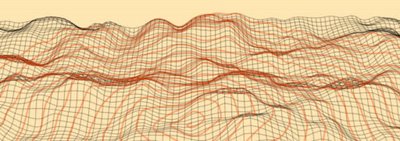  Much more – including terrestrial wave-animations and other forms of textual "terrain generation" – at Chronotext.org. (Via Coudal. Earlier: Paper topographies: 1).
I first discovered Mike Davis's work about a decade ago, through his book City of Quartz, a detailed and poetic look at the social geography of Los Angeles. Perhaps most memorably, City of Quartz describes the militarization of public space in LA, from the impenetrable "panic rooms" of Beverly Hills mansions to the shifting ganglands of South Central. Not only does the Los Angeles Police Department use "a geo-synchronous law enforcement satellite" in their literal oversight of the city, but "thousands of residential rooftops have been painted with identifying street numbers, transforming the aerial view of the city into a huge police grid." In Los Angeles today, "carceral structures have become the new frontier of public architecture." Many of Davis's conclusions will annoy you – but that's half the point of reading his books.  A more wide-ranging book is Davis's 2002 collection Dead Cities. While it's one of Davis's least cohesive books, it nonetheless ends with an invigorating bang. Its final section, called "Extreme Science," is a perfect example of how Davis's books remain so consistently interesting. We come across asteroid impacts, prehistoric mass extinctions, Victorian disaster fiction, planetary gravitational imbalances, and even the coming regime of human-induced climate change, all in a book ostensibly dedicated to West Coast American urbanism. Of course, Mike Davis's particular breed of urban sociology has found many detractors – detractors who accuse Davis of falsifying his interviews, performing selective research, deliberately amplifying LA's dark side (whether that means plate tectonics, police brutality, or race riots), and otherwise falling prey to partisan battles in which Davis's classically Marxist approach seems both inadequate and outdated. In fact, these criticisms are all justified in their own ways – yet I still find myself genuinely excited whenever a new book of his hits the bookshop display tables. In any case, the following interview took place after the publication of Davis's most recent book, Planet of Slums. Having reviewed that book for the Summer 2006 issue of David Haskell's Urban Design Review, I won't dwell on it at length here; but Planet of Slums states its subject matter boldy, on page one. There, Davis writes that we are now at "a watershed in human history, comparable to the Neolithic or Industrial revolutions. For the first time the urban population of the earth will outnumber the rural." This "urban" population will not find its home inside cities, however, but deep within horrific mega-slums where masked riot police, raw human sewage, toxic metal-plating industries, and emerging diseases all violently co-exist with literally billions of people. Planet of Slums quickly begins to read like some Boschian catalog of our era's most nightmarish consequences. The future, to put it non-judgmentally, will be interesting indeed. Mike Davis and I spoke via telephone. •BLDGBLOG: First, could you tell me a bit about the actual writing process of Planet of Slums? Was there any travel involved?Davis: This was almost entirely an armchair journey. What I tried to do was read as much of the current literature on urban poverty, in English, as I could. Having four children, two of them toddlers, I only wish I could visit some of these places. On the other hand, I write from our porch, with a clear view of Tijuana, a city I know fairly well, and that’s influenced a lot of my thinking about these issues – although I tried scrupulously to avoid putting any personal journalism into the narrative. Really, the book is just an attempt to critically survey and synthesize the literature on global urban poverty, and to expand on this extraordinarily important report of the United Nations – The Challenge of Slums – which came out a few years ago. BLDGBLOG: So you didn't visit the places you describe?Davis: Well, I was initially anticipating writing a much longer book, but when I came to what should have been the second half of Planet of Slums – which looks at the politics of the slum – it became just impossible to rely on secondary or specialist literature. I’m now collaborating on a second volume with a young guy named Forrest Hylton, who’s lived for several years in Colombia and Bolivia. I think his first-hand experience and knowledge makes up for most of my deficiencies, and he and I are now producing the second book.  BLDGBLOG BLDGBLOG: I’m curious about the vocabulary that you use to describe this new “post-urban geography” of global slums: regional corridors, polycentric webs, diffuse urbanism, etc. I’m wondering if you’ve found any consistent forms or structures now arising, as cities turn away from centralized, geographically obvious locations, becoming fractal, slum-like sprawl.Davis: First of all, the language with which we talk about metropolitan entities and larger-scale urban systems is already eclectic because urban geographers avidly debate these issues. I think there’s little consensus at all about the morphology of what lies beyond the classical city. The most important debates really arose through discussions of urbanization in southern China, Indonesia, and southeast Asia – and that was about the nature of peri-urbanization on the dynamic periphery of large Third World cities. BLDGBLOG: And "peri-urbanization" means what?Davis: It’s where the city and the countryside interpenetrate. The question is: are you, in fact, looking at a snapshot of a very dynamic or perhaps chaotic process? Or will this kind of hybrid quality be preserved over any length of time? These are really open questions. There are several different discussions here: one on larger-order urban systems – similar to the Atlantic seaboard or Tokyo-Yokohama, where metropolitan areas are linked in continuous physical systems. But then there’s this second debate about the spill-over into the countryside, this new peri-urban reality, where you have very complex mixtures of slums – of poverty – crossed with dumping grounds for people expelled from the center – refugees. Yet amidst all this you have small, middle class enclaves, often new and often gated. You find rural laborers trapped by urban sweatshops, at the same time that urban settlers commute to work in agricultural industries. This, in a way, is the most interesting – and least-understood – dynamic of global urbanization. As I try to explain in Planet of Slums, peri-urbanism exists in a kind of epistemological fog because it’s not well-studied. The census data and social statistics are notoriously incomplete.  BLDGBLOG BLDGBLOG: So it's more a question of how to study the slums – who and what to ask, and how to interpret that data? Where to get your funding from?Davis: At the very least, it’s a challenge of information. Interestingly, this has also become the terrain of a lot of Pentagon thinking about urban warfare. These non-hierarchical, labyrinthine peripheries are what many Pentagon thinkers have fastened onto as one of the most challenging terrains for future wars and other imperial projects. I mean, after a period in which the Pentagon was besotted with trendy management theory – using analogies with Wal-Mart and just-in-time inventory – it now seems to have become obsessed with urban theory – with architecture and city planning. This is happening particularly through things like the RAND Corporation’s Arroyo Center, in Santa Monica. The U.S. has such an extraordinary ability to destroy hierarchical urban systems, to take out centralized urban structures, but it has had no success in the Sadr Cities of the world. BLDGBLOG: I don't know – they leveled Fallujah, using tank-mounted bulldozers and Daisy Cutter bombs –Davis: But the city was soon re-inhabited by the same insurgents they tried to force out. I think the slum is universally recognized by military planners today as a challenge. I wouldn’t be at all surprised if there’s a great leap forward in our understanding of what’s happening on the peripheries of Third World cities because of the needs of Pentagon strategists and local military planners. For instance, Andean anthropology made a big leap forward in the 1960s and early 1970s when Che Guevara and his guerilla fighters became a problem. I think there’s a consensus, both on the left and the right, that it’s the slum peripheries of poor Third World cities that have become a decisive geopolitical space. That space is now a military challenge – as much as it is an epistemological challenge, both for sociologists and for military planners.  BLDGBLOG BLDGBLOG: What kind of imaginative role do you see slums playing today? On the one hand, there's a kind of CIA-inspired vision of irrational anti-Americanism, mere breeding grounds for terrorism; on the other, you find books like The Constant Gardener, in which the Third World poor are portrayed as innocent, naive, and totally unthreatening, patiently awaiting their liberal salvation. Whose imaginination is it in which these fantasies play out?Davis: I think, actually, that if Blade Runner was once the imaginative icon of our urban future, then the Blade Runner of this generation is Black Hawk Down – a movie I must admit I’m drawn to to see again and again. Just the choreography of it – the staging of it – is stunning. But I think that film really is the cinematic icon for this new frontier of civilization: the “white man’s burden” of the urban slum and its videogame-like menacing armies, with their RPGs in hand, battling heroic techno-warriors and Delta Force Army Rangers. It’s a profound military fantasy. I don’t think any movie since The Sands of Iwo Jima has enlisted more kids in the Marines than Black Hawk Down. In a moral sense, of course, it’s a terrifying film, because it's an arcade game – and who could possibly count all the Somalis that are killed? BLDGBLOG: It’s even filmed like a first-person shooter. Several times you're actually watching from right behind the gun.Davis: It’s by Ridley Scott, isn’t it? BLDGBLOG: Yeah – which is interesting, because he also directed Blade Runner. Davis: Exactly. And he did Black Rain, didn’t he? BLDGBLOG: The cryptic threat of late-1980s Japan…Davis: Ridley Scott – more than anyone in Hollywood – has really defined the alien Other. Of course, in reality, it’s not white guys in the Rangers who make up most of the military presence overseas: it’s mostly slum kids themselves, from American inner cities. The new imperialism – like the old imperialism – has this advantage, that the metropolis itself is so violent, with such concentrated poverty, that it produces excellent warriors for these far-flung military campaigns. I remember reading a brilliant book once by a former professor of mine, at the University of Edinburgh, on British imperial warfare in the nineteenth century. He showed, against every expectation, that, in fact, most often for the British Army, in imperial wars, what was decisive wasn’t their possession of better weapons, or artillery, or Maxim guns: it was the ability of the British soldier to engage in personal carnage, hand-to-hand combat, up close with bayonets – and that was strictly a function of the brutality of life in British slums. Now, if you read the literature on warfare today, this is what the Pentagon’s really capitalizing on: they’re using the American inner city as a kind of combat laboratory, in addition to these urban test ranges they’ve built to study their new technologies. The slum dwellers’ response to this, and it’s a response that has yet to be answered – and maybe it’s unanswerable – is the poor man’s Air Force: the car bomb. That’s the subject of another book I’m finishing up right now, a short history of the car bomb. That has to be one of the most decisive military innovations of the late twentieth century. If you look at what’s happening in Iraq, it may be the Improvised Explosive Devices (IEDs) that are killing Americans, but what’s just ripping that country apart is these fortified car bomb attacks. The car bomb has given poor people in slums – small groups and networks – a new, extremely traumatic kind of geopolitical leverage. What’s happened, I think, at the end of the 20th century – and at the beginning of the 21st – is that the outcasts have discovered these extraordinarily cheap and horrific weapons. That's why I argue, in Planet of Slums, that they have “the gods of chaos” on their side.  BLDGBLOG BLDGBLOG: Beyond a turn toward violence and insurgency, do you see any intentional, organized systems of self-government emerging in the slums? Is there a slum “mayor,” for instance, or a kind of slum city hall? In other words, who would a non-military power negotiate with in the first place?Davis: Organization in the slums is, of course, extraordinarily diverse. The subject of the second book – that I’m writing with Forrest Hylton – will be what kinds of trends and unities exist within that diversity. Because in the same city – for instance, in a large Latin American city – you’ll find everything from Pentacostal churches to the Sendero Luminoso, to reformist organizations and neoliberal NGOs. Over very short periods of time there are rapid swings in popularity from one to the other – and back. It’s very difficult to find a directionality in that, or to predict where things might go. But what is clear, over the last decade, is that the poor – and not just the poor in classical urban neighborhoods, but the poor who, for a long time, have been organized in leftwing parties, or religious groups, or populist parties – this new poor, on the fringes of the city, have been organizing themselves massively over the last decade. You have to be struck by both the number and the political importance of some of these emerging movements, whether that’s Sadr, in Iraq, or an equivalent slum-based social movement in Buenos Aires. Clearly, in the last decade, there have been dramatic increases in the organization of the urban poor, who are making new and, in some cases, unprecedented demands for political and economic participation. And where they are totally excluded, they make their voices heard in other ways. BLDGBLOG: Like using car bombs?Davis: I mean taking steps toward formal democracy. Because the other part of your question concerns the politics of poor cities. I’m sure that somebody could write a book arguing that one of the great developments of the last ten or fifteen years has been increased democratization in many cities. For instance, in cities that did not have consolidated governments, or where mayors were appointed by a central administration, you now have elections, and elected mayors – like in Mexico City. What’s so striking, in almost all of these cases, is that even where there’s increased formal democracy – where more people are voting – those votes actually have little consequence. That’s for two reasons: one is because the fiscal systems of big cities in the Third World are, with few exceptions, so regressive and corrupt, with so few resources, that it’s almost impossible to redistribute those resources to voting people. The second reason is that, in so many cities – India is a great example of this – when you have more populist or participatory elections, the real power is simply transferred into executive agencies, industrial authorities, and development authorities of all kinds, which tend to be local vehicles for World Bank investment. Those agencies are almost entirely out of the control of the local people. They may even be appointed by the state or by a provisional – sometimes national – government. This means that the democratic path to control over cities – and, above all, control over resources for urban reform – remains incredibly elusive in most places.  (This interview continues in Part Two. For another, recent two-part interview with Mike Davis, see TomDispatch: Part 1, Part 2. All drawings used in this interview are by Leah Beeferman, who was also behind BLDGBLOG's Helicopter Archipelago).
   [Images: The structural science of vortex rings. "A vortex ring forms when a very quick burst of fluid shoots out of an opening," Freud writes – er, this article tells us. "As the fluid moves forwards, it spreads out and its front edges curl back. If the speed of the burst is fast enough, the curling fluid eventually curls all the way round, until it is travelling forwards again in the direction of the original burst." Etc. So could such vortices be used as a new form of undersea propulsion – or perhaps an underwater art show, perfect vortices spiraling off through colored water, liquid crystals, magma? If you're still curious, this PDF version of the New Scientist article mentioned above will tell you all about the fluid-mechanical work of Kamran Mohseni and Mory Gharib, including a brief aside on "superfluid gyros" and "vortex-formation velocity."]
 Though I may be late to the game here, I've recently discovered the origami of Eric Gjerde. These are all examples of his work, taken from Eric's various flickr sets: surface become structure; paper, terrain; folds made into space and topography.     Methods, tips, techniques, etc., can all be found on his website. (Somewhat related: the paper sculptures of Richard Sweeney).
Continuing our recent, if somewhat unexpected, ant theme, here is a project that maps the paths of walking ants.  The project, by Sean Dockray, consists of a short video loop that "documents a pheromonal portrait made by Argentine ants. While the ants in the video are real (they were shot in a single 45 minute long take) the trails are created in a piece of custom software, which tracks each ant frame-by-frame." 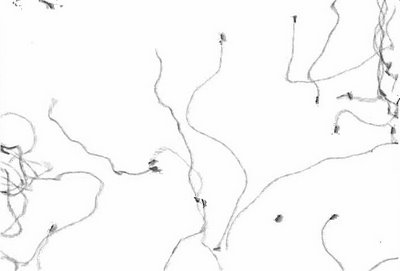 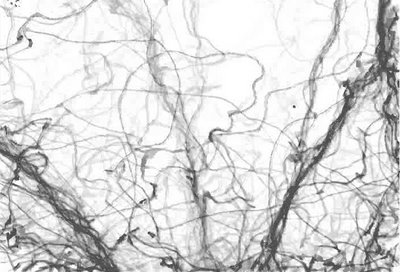 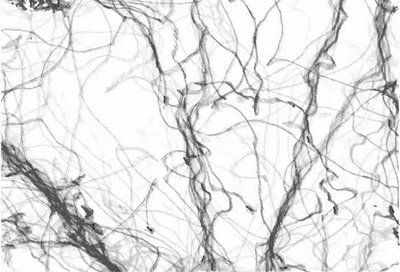 "The more that ants walk on a particular path, the darker that paths gets. Over time, the paths either disappear or are reinforced by more walking. In this way, the video is a kind of mutable, spatialized collective memory." (See also Wormholes in Wood, and the almost unbelievable images of subterranean ant architecture at Nest-casting; and thanks to Sean Dockray for supplying the filmstills!).
 The Gear Tek Corporation takes us on a brief visit to " the longest building I have ever seen," located somewhere in the "physically oppressive and hallucinatory" flatlands of Illinois. 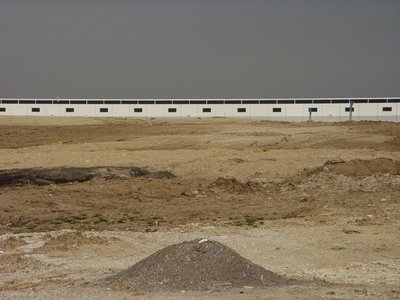 "This is the longest building I have ever seen," GTC writes. "It is totally windowless and stretches for at least a mile, although it seems to defy laws of space-time so it may be longer or shorter than that." The building's absolute superlinearity appears really to be a "spatial illusion" that is only amplified by the "simple gray rectangles which glide along the blank facade like dotted lines on an overlay. It looks like an Ellsworth Kelly interpretation of Superman chasing a train." What's the building? Who knows – but you can read more about it at the original post. (Thanks to Tim Drage for the tip!)
 [Image: Here we see phytoplankton illuminating the Denmark Strait, forming solar-mineral arabesques, glowing traces. "While phytoplankton are tiny taken by themselves, together they can cause color shifts in ocean water, which in turn is detected by orbiting spacecraft." Next, you build triangular frames, squares and circles afloat on the ocean – then fill them all in with phytoplankton: a sea of shining geometry. Cubes of light cast adrift across the North Sea, photographed from below by divers. Courtesy European Space Agency].
|
|













































